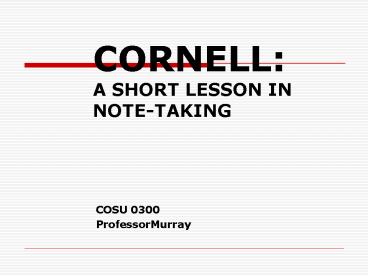CORNELL: A SHORT LESSON IN NOTE-TAKING - PowerPoint PPT Presentation
1 / 13
Title:
CORNELL: A SHORT LESSON IN NOTE-TAKING
Description:
CORNELL: A SHORT LESSON IN NOTE-TAKING COSU 0300 ProfessorMurray WHAT IS CORNELL? An active learning process A system of note taking designed to maximize time and ... – PowerPoint PPT presentation
Number of Views:65
Avg rating:3.0/5.0
Title: CORNELL: A SHORT LESSON IN NOTE-TAKING
1
CORNELLA SHORT LESSON IN NOTE-TAKING
- COSU 0300
- ProfessorMurray
2
WHAT IS CORNELL?
- An active learning process
- A system of note taking designed to maximize time
and efficiency - An organization tool
- A tool used for study and review
3
BACKGROUND
- Developed by Walter Pauk of Cornell University
- One of the most commonly used note taking systems
- Students needed a more effective way to take
notes
4
WHY WOULD I USE THIS?
- Organized and systematic
- Allows you to record/review notes
- Stay actively engaged in material
- Easy format
- Saves time and effort
- Built in feedback
5
THE STEPS
- Remember the Rs
- Record
- Reduce
- Recite
- Reflect
- Review
6
SETTING UP CORNELL NOTES
- 2 columns, approx. 2 ½ in. and 6 in.
- Notes labeled with topic, date, class, chapter ,
etc. - Why?
7
RECORD
- Recording of notes from book or lecture done in
the larger column - NOT word for word
- Make it simple use abbreviations, short hand,
summaries whenever possible - Use headings, numbers, dashes, etc. to divide
information and KEEP IT ORGANIZED! - Leaves spaces if necessary to fill in later
- Keep writing!
- Record only main ideas and important details be
selective
8
REDUCE
- When? As soon as possible.
- Where? In the smaller column.
- What? Take your right-hand column notes and
reduce into key words, phrases, and questions. - Why? These will serve as memory cues and aid in
your studying. FEEDBACK - Practice Reduce the following piece of
information. - Numbering ideas in your notes helps you remember
how many important points are in each section.
9
RECITE
- Speak out loud
- Use own words
- Self-Explaining
- Check for Understanding
- Use feedback what needs clarification? What
needs to be studied further?
10
REFLECT
- Think or consider seriously
- Think about your notes
- Create summaries
- Create outlines
- Create study tools (index cards, maps, drawings,
lists, study tapes, etc.) - Explain to a study partner
11
REVIEW
- Immediately and often!
- Why?
- Curve of Forgetting look at this
12
STEP BY STEP
REDUCE (After lecture) RECORD (During lecture)
REDUCE Key words, phrases, or questions (in your own words) RECITE (out loud, in own words, using reduce column as prompts) RECORD 1. Write down facts, ideas, and phrases 2. Use abbreviations (when possible) 3. Read through your notes (after lecture) 4. Fill in the blanks and make more legible (after lecture) REFLECT 1. Questions 2. Summaries 3. Associations) REVIEW 1. Immediately and often
Write a summary of your notes here in complete sentences
13
PRACTICE AND APPLICATION
- Take a set of Cornell notes over The 5 Theories
of Forgetting on pp.266-267 in your COSU text.































